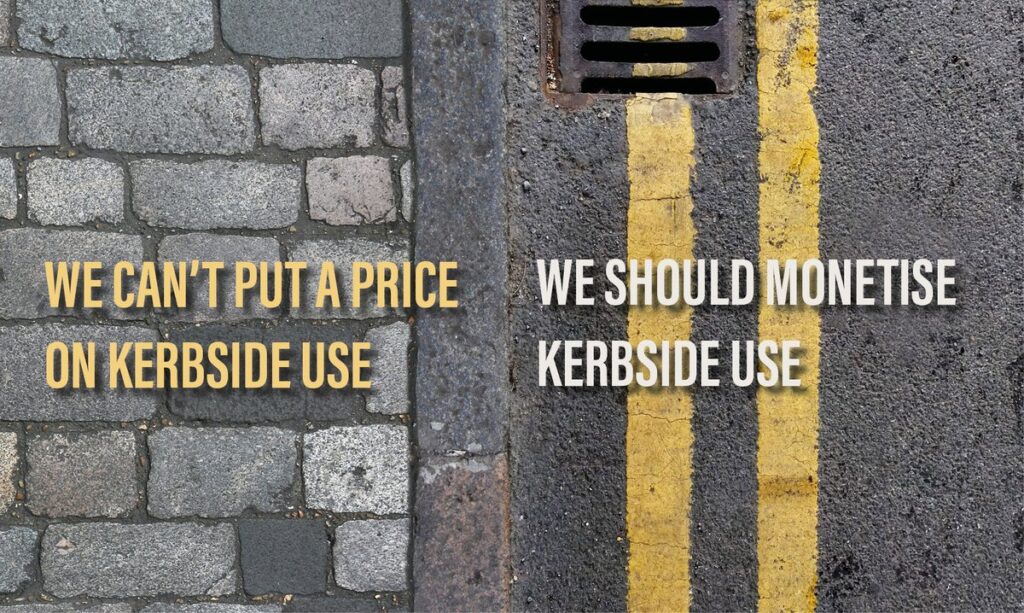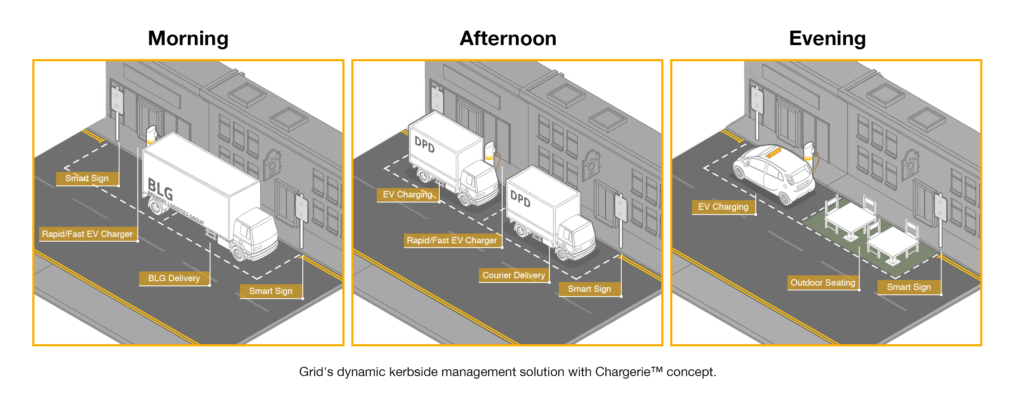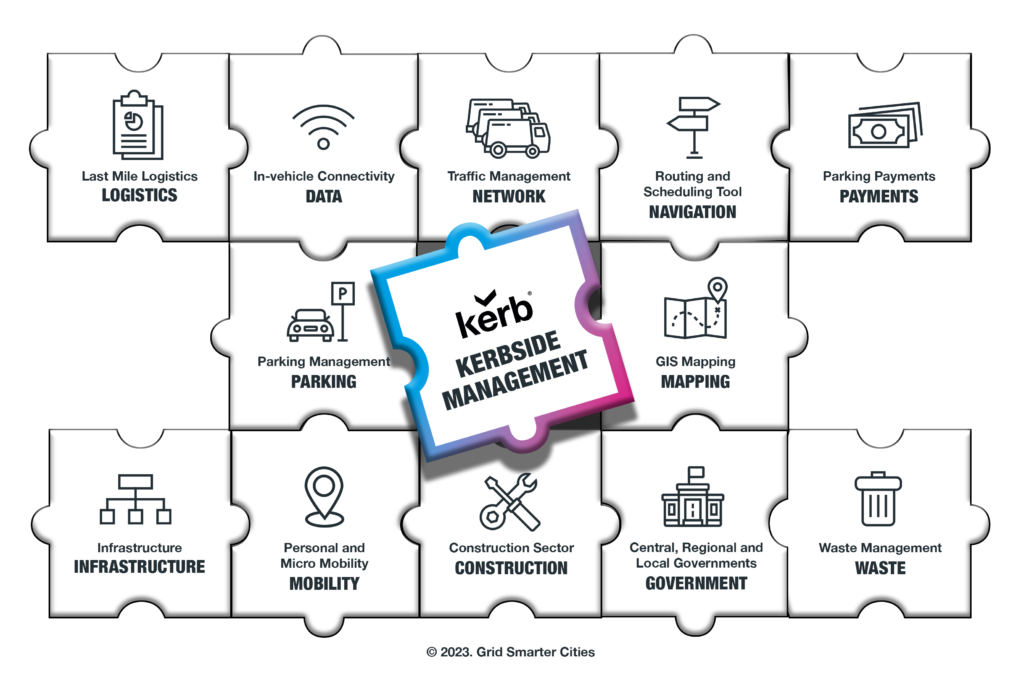Is the humble kerb the missing puzzle piece that unlocks the digital ecosystem needed to deliver social, environmental, and economic benefits for cities and accelerate fleet transition to EV?

Grid’s CEO Neil Herron writes a blog for TRL Kerbside Taskforce. Download the article.
Whilst some smart city thinkers have been looking skywards for inspiration and thinking aerial drone deliveries are a solution, others recognise the answer has been under our feet all this time. The kerb is currently a fixed two-dimensional asset where many interactions take place, whether it’s pickup, drop off, loading zones, bus stops, clearways, cycle lanes or parking spots. With the first come first served jostling for position creating a complex, messy and often unsafe environment. It doesn’t have to be this way. Kerb Owners (mostly local authorities) need to be able to visualise and utilise their kerbside as a digitalised 3D gateway to enable the delivering of safer, greener, and cleaner places in which to live and work.
At Grid Smarter Cities, we believe that we are ‘at the cutting edge of common sense!’ as we have created a kerbside management platform Kerb® that provides the kerb owner with the ability to flex permitted use of its kerb by times of day and user types to better reflect local safety and prioritisation hierarchies. By adding a pre-bookable element it gives an increased degree of certainty of access and timing for kerb users (freight, servicing and delivery vehicles).
Dwell permissions can be tailored to industry need, whether they be physical bookable loading bays, virtual loading bays, zonal permits or dwell extensions and layered over the kerbspace as a ‘digital wrapper’ delivering the optimal outcomes for all stakeholders. The biggest environmental, social and economic gains come from this very practical intervention of re-prioritising the kerb from a first come first served ‘free for all’ to a dynamic and flexibly managed bookable asset. Practical solutions such as Kerb, will allow the Amazons and DPDs to safely and more sustainably deliver 160 parcels in a day instead of 130, for example. Their interactions with the kerbside, known, understood and permitted, will lead to better network, less congestion, fewer miles driven, and reduced air pollution, and with lower driver stress and fewer parking tickets! These are the marginal gains from doing little things a little better and for the operator, this means greater margins.
The Brewery Logistics sector is different in that it works under strict safety guidelines when delivering. Its operational needs are therefore different from the parcel sector as they require prioritised access to the kerb close to the cellar doors, often in areas where loading may otherwise be prohibited. And if they have to deliver across a cycle lane to access the cellar then this inevitably brings in another layer of complexity and danger. This can be avoided right now by using technology to deliver safer and more efficient use of road and kerb space with pre-booked, risk assessed loading at specific times that least impact on the network
What are the things we need to think about?
We need not wait for new technology, policy or legislation to realise the early benefits. The technology and solutions are available now! The Department for Transport (DfT) recently commissioned a Kerbside Management Discovery Report which identified the enabling power of the kerb and significant outcomes that can be delivered in the short term whilst preparing the policy and legislative road map for a fully digital, flexible and dynamic approach to kerbside access.
The beauty for local authorities is that they don’t each need to design their own solution. Kerb can be configured to easily address local, city, or region-wide challenges. Accelerating fleets transitioning to full EV by overcoming range and charger anxiety by linking the ability to pay for kerbside parking and charging in a single transaction.
Fleet transition to full EV will be accelerated by overcoming challenges of range and charger anxiety,and by linking the ability to book and pay for kerbside parking and charging in a single transaction. The ability to book a charging slot is also going to be key for the kerb owner and chargepoint operator when deciding where to install a charger to optimise the asset value. With the most obvious ‘graze’ users being the ones already dwelling at the kerb whilst making a delivery.
To transition, fleets will require charging certainty and a guarantee of access as part of the last mile consideration and this complements the emerging strategy of dedicated charging and parking hubs adjacent to city centres as part of a mid-mile strategy.

How can we progress?
Progress can be made quite rapidly, with beneficial outcomes demonstrated, proved and then taken to scale. Much of the groundwork has been done by Government and local authorities to highlight the need to digitise Traffic Regulation Orders which will enable the layering of ‘solution additionality’ over their existing fixed two-dimensional kerbside assets.
Benefits
A mid to large scale demonstrator evidencing a kerbside management solution for freight, servicing and delivery vehicles, delivering social, environmental, and economic benefits for both the kerb owners and the kerb users.
EV Transition
Recognising the kerbspace is the missing jigsaw piece to enable decarbonisation of fleets. Integrating EV strategy with mid-mile and last mile, and complementing on-street graze charging with off-street park and charge.
Certainty
Pre-bookable kerbside slots creates both certainty and increased throughput of only those vehicles that are need to be there. Providing certainty of access and charging to commercial fleets in the day and residents at night signposts the flexible and dynamic approach to delivering future policy goals.
Whilst the number of stakeholders may appear to be complex, if we view the landscape as an interconnected, interoperable digital ecosystem then the kerb is uniquely placed as a strategic enabler as can be seen from the diagram here.

Kerb Owner Benefits

Reduce CO2 emmisions by 15,500 tonnes per annum
(more than the 12,300 tonnes for CO2 saved by ULEZ per annum)

Equivalent to removing 12,600 cars off the road per annum

The scheme could generate up to £140 million in revenue for London per annum
and substantially improve safety on the capital’s road
Kerb User Benefits

Saves over 3 million hours in wasted delivery driver time per annum
by removing the hassle of finding safe and available kerbside locations to park

Enables 21% more deliveries by improving operational efficiency

Reduces freight, servicing and delivery kilometres by 20 million per annum in London
helping to ease congestion and improve safety in the capital
The Author
Neil Herron
CEO and Founder | Grid Smarter Cities
A serial entrepreneur founded award-winning Grid Smarter Cities in 2015, developing new propositions in the smart, connected urban ecosystem space in particular addressing the issues of kerbside management to help deliver optimisation and efficiencies for co commercial operators and reduced congestion, improved air quality and Net Zero and decarbonisation strategies for cities. Former European Campaigner of the Year influencing government policy and named inventor behind 15 granted patents delivering digital innovation in the areas of parking, journey planning and waste management. A regular commentator on kerbside management, contributing to the recent Department for Transport Kerbside Management Discovery Report as part of the expert panel. He is a Department for International Trade Export Champion.